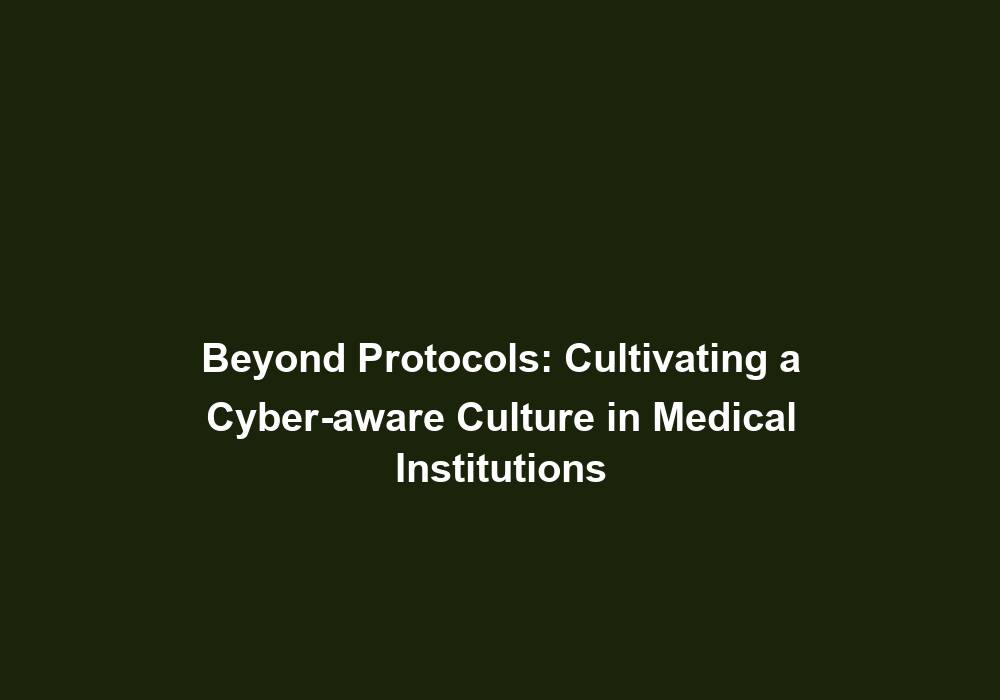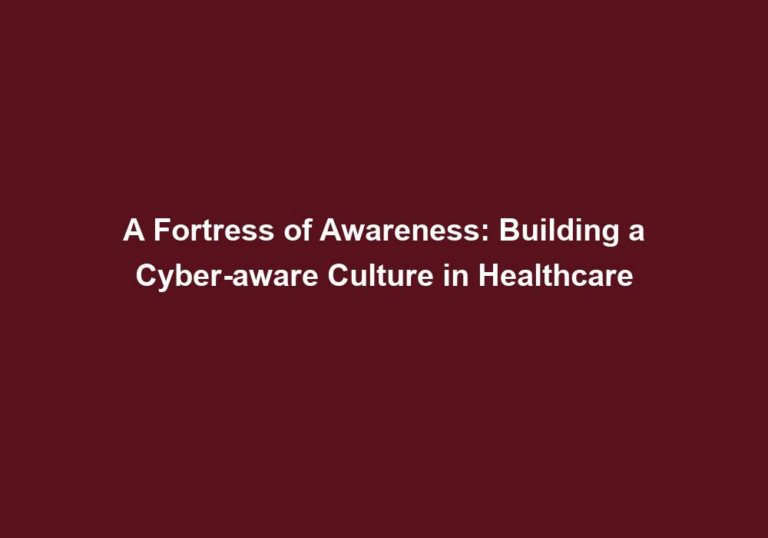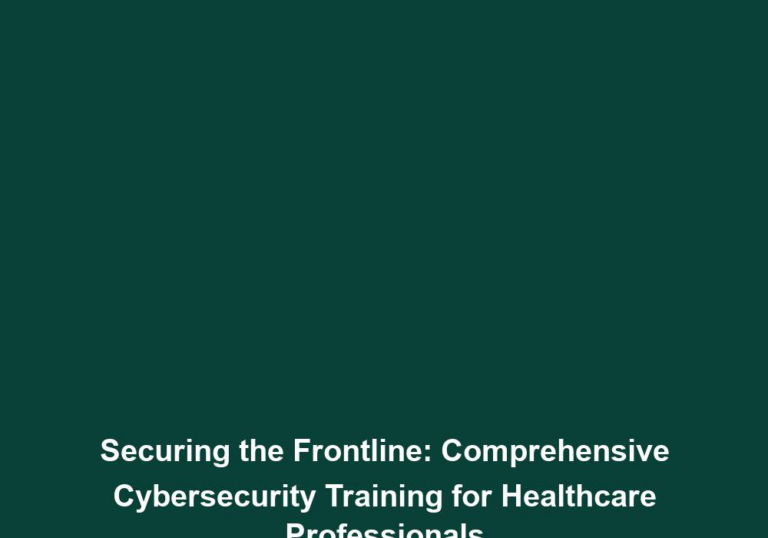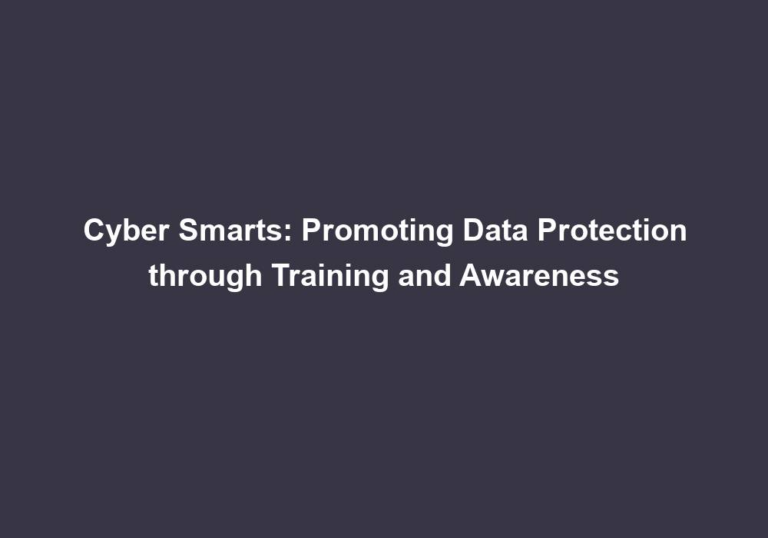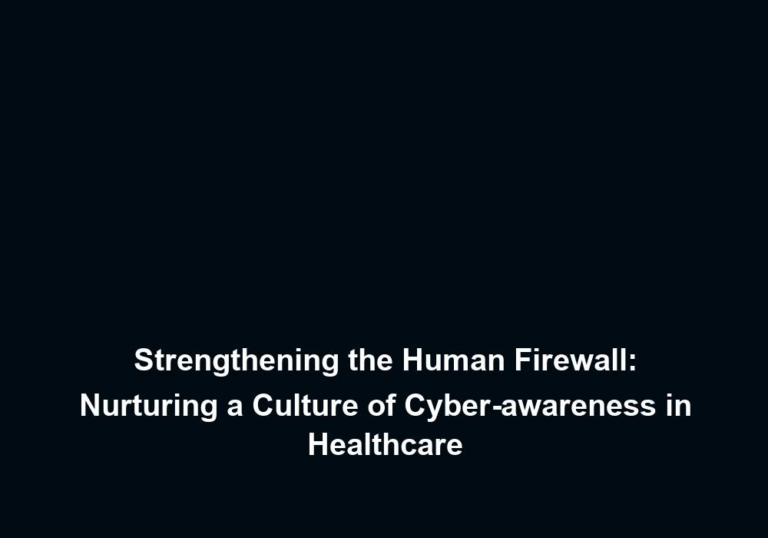Beyond Protocols: Cultivating a Cyber-aware Culture in Medical Institutions
In today’s digital age, medical institutions face an ever-growing threat of cyber attacks and data breaches. With sensitive patient information at stake, it is crucial for these organizations to go beyond basic protocols and establish a cyber-aware culture. By fostering a culture of cybersecurity, medical institutions can effectively protect patient data, maintain their reputation, and ensure the continuity of their services. This article explores key strategies and best practices that can help cultivate a cyber-aware culture within medical institutions.
Understanding the Cybersecurity Landscape
Before delving into the strategies, it is essential to comprehend the cybersecurity landscape in medical institutions. Healthcare organizations are attractive targets for cybercriminals due to the wealth of personal data they possess, ranging from medical records to insurance details. These cyber threats can have severe consequences, such as compromised patient care, financial loss, and reputational damage.
To address these risks effectively, medical institutions need to understand the various types of cyber threats they may face:
- Malware and Ransomware Attacks: Malicious software can infiltrate medical systems, encrypting data or causing operational disruptions until a ransom is paid.
- Phishing: Cybercriminals may attempt to trick employees into revealing sensitive information through deceptive emails or websites.
- Insider Threats: Unauthorized access or intentional data breaches by employees can pose significant risks to patient data security.
- IoT Vulnerabilities: Connected medical devices, if not properly secured, can be exploited by hackers to gain access to the network and sensitive information.
By recognizing these threats, medical institutions can better tailor their cybersecurity efforts to address specific vulnerabilities and mitigate risks effectively.
The Role of Leadership in Cybersecurity
To establish a cyber-aware culture, leadership plays a pivotal role. Top-level executives, including CEOs and CIOs, must prioritize cybersecurity and actively promote its importance throughout the organization. This commitment should be reflected in their actions, such as:
- Resource Allocation: Adequate resources should be allocated to cybersecurity initiatives, including budget, personnel, and technology investments.
- Staying Informed: Leaders need to stay updated on the latest cybersecurity threats, trends, and best practices to make informed decisions.
- Promoting Responsibility: Leaders should foster a sense of responsibility among staff members, emphasizing the importance of cybersecurity in their roles.
- Leading by Example: Executives should adhere to security protocols themselves, reinforcing the message that cybersecurity is everyone’s responsibility.
By demonstrating a strong commitment to cybersecurity, leaders set the tone for the entire organization and encourage a culture of vigilance.
Building Cybersecurity Awareness Among Staff
Educating and training staff members about cybersecurity risks and preventive measures is crucial for cultivating a cyber-aware culture. This includes providing comprehensive training programs that cover topics such as:
- Phishing Awareness: Staff should be trained to identify phishing attempts and avoid clicking on suspicious links or providing sensitive information.
- Password Security: Employees should be educated on creating strong passwords and regularly updating them to prevent unauthorized access.
- Recognizing Vulnerabilities: Training programs should teach employees how to identify potential vulnerabilities, such as outdated software or weak network security.
- Data Handling Best Practices: Staff members should understand proper data handling procedures, including secure file transfers, data backup protocols, and the importance of encryption.
Regular workshops, seminars, and awareness campaigns should be conducted to ensure that employees remain vigilant and proactive in safeguarding sensitive information. Employee engagement and feedback should be encouraged to continually improve cybersecurity practices.
Implementing Strong Access Controls
Access controls are fundamental to protecting patient data. Medical institutions should implement robust authentication measures to ensure that only authorized personnel can access sensitive information. This includes:
- Strong Password Policies: Enforce password complexity requirements, regular password changes, and discourage password sharing.
- Multi-factor Authentication (MFA): Implement MFA to add an extra layer of security by requiring additional verification steps, such as a unique code sent to a mobile device.
- Regular Access Reviews: Conduct regular reviews of user access privileges to promptly revoke access when an employee leaves the organization or changes roles.
- Role-Based Access Control (RBAC): Limit access to data based on an individual’s responsibilities, ensuring that employees only have access to the information necessary for their job functions.
By implementing these access controls, medical institutions can minimize the risk of unauthorized access and protect patient data from potential breaches.
Securing Network Infrastructure
Medical institutions rely heavily on their network infrastructure to support various operations. It is crucial to secure this infrastructure to prevent unauthorized access and potential data breaches. Key steps to secure the network infrastructure include:
- Firewalls: Implement firewalls to monitor and control incoming and outgoing network traffic, blocking unauthorized access attempts.
- Encryption: Encrypt data transmissions to protect sensitive information as it travels across the network, making it unreadable to unauthorized individuals.
- Regular Updates: Keep network equipment, including routers and switches, up to date with the latest firmware and security patches to address any known vulnerabilities.
- Vulnerability Assessments and Penetration Testing: Regularly assess the network infrastructure for vulnerabilities and conduct penetration testing to identify and address potential weaknesses before they can be exploited.
By proactively securing the network infrastructure, medical institutions can significantly reduce the risk of cyber attacks and data breaches.
Prioritizing Data Encryption and Backup
Data encryption is a crucial component of a comprehensive cybersecurity strategy. By encrypting sensitive patient data, medical institutions can ensure that even if it falls into the wrong hands, it remains unreadable and useless. Key considerations for data encryption include:
- Encryption Algorithms: Implement robust encryption algorithms to protect data at rest and in transit, such as the Advanced Encryption Standard (AES).
- Secure Key Management: Establish secure key management practices to safeguard encryption keys and prevent unauthorized access.
- Offline or Isolated Network Storage: Regular data backups should be performed and securely stored, either offline or in an isolated network, to prevent unauthorized access and ensure data availability in case of a breach or system failure.
By prioritizing data encryption and backup, medical institutions can minimize the potential impact of data breaches and maintain the confidentiality of patient information.
Establishing Incident Response and Recovery Plans
Despite the best preventive measures, medical institutions should be prepared for potential cybersecurity incidents. Establishing incident response and recovery plans enables organizations to respond quickly and efficiently in the event of a data breach or cyber attack. Key elements of these plans include:
- Incident Reporting Procedures: Clear procedures should be in place for employees to report suspected incidents promptly.
- Investigation and Containment: Plans should outline procedures for investigating the root causes of incidents and containing the damage to prevent further compromise.
- Notification and Communication: Clear guidelines should be established for notifying affected parties, such as patients, regulatory authorities, and law enforcement, while maintaining open and transparent communication.
- System Recovery: Plans should include steps for recovering compromised systems, restoring data from backups, and implementing additional security measures to prevent future incidents.
Regular rehearsals and simulations are essential to ensure the effectiveness of these plans and enable quick response and recovery when needed.
Promoting a Culture of Vigilance
Cultivating a cyber-aware culture requires fostering a sense of vigilance among all staff members. Key strategies to promote this culture include:
- Encouraging Reporting: Employees should be encouraged to report any suspicious activities or potential security incidents promptly.
- Sharing Cybersecurity News and Updates: Regularly disseminate cybersecurity news, updates, and best practices to keep employees informed about emerging threats and preventive measures.
- Open Communication Channels: Create channels for open communication, such as anonymous reporting mechanisms or dedicated cybersecurity awareness forums, to encourage dialogue and information sharing.
- Reminders and Refresher Training: Regularly remind employees about cybersecurity best practices and conduct refresher training sessions to reinforce the importance of their role in safeguarding sensitive data.
By promoting a culture of vigilance, medical institutions empower their employees to be proactive in identifying and mitigating cybersecurity risks.
Partnering with Cybersecurity Experts
Medical institutions can benefit greatly from partnering with cybersecurity experts to strengthen their defenses. Collaborating with reputable cybersecurity firms or consultants can provide valuable insights, perform comprehensive risk assessments, and recommend tailored solutions. These experts can assist in:
- Risk Assessment: Conducting thorough risk assessments to identify vulnerabilities and prioritize mitigation efforts.
- Best Practice Implementation: Ensuring that industry best practices are implemented, such as compliance with regulations like the Health Insurance Portability and Accountability Act (HIPAA) or General Data Protection Regulation (GDPR).
- Threat Intelligence: Staying updated on emerging threats and trends to proactively adapt security measures and protect against new attack vectors.
- Incident Response Support: Providing guidance and support during cybersecurity incidents, helping medical institutions respond effectively and recover efficiently.
By leveraging the expertise of cybersecurity professionals, medical institutions can enhance their cybersecurity posture and better protect patient data.
Conclusion
In conclusion, medical institutions must go beyond protocols to cultivate a cyber-aware culture. By understanding the cybersecurity landscape, prioritizing leadership involvement, educating staff members, implementing strong access controls, securing network infrastructure, prioritizing data encryption and backup, establishing incident response and recovery plans, promoting a culture of vigilance, and partnering with cybersecurity experts, these organizations can significantly enhance their cybersecurity posture. Ultimately, a cyber-aware culture is essential to safeguard patient data, maintain trust, and uphold the integrity of medical institutions in an increasingly digital world.

